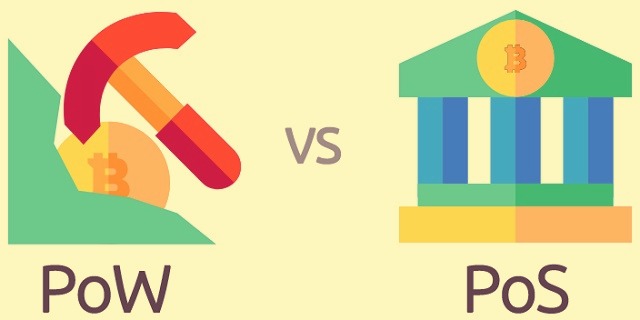Proof-of-Work and Proof-of-Stake are the most popular consensus algorithms in cryptocurrencies among the miners. They offer proof mechanisms with different structures. Mining allows the infrastructure of the blockchain to work. Due to the lack of centralization in a distributed network, users make all the calculations. However, they need payment for the network support. There are different approaches for that. We will describe two most common of them below.
Table of Contents
Proof-of-Work
This is a classic version of mining, which is used in Bitcoin and many other cryptocurrencies. The point is that miners compete in their computing power for mining the block, issuing the new coins and receiving the commission. This protocol protects distributed systems from cyber attacks like DDoS and spam. This concept was invented in 1993 by C. Dwork and M. Naor. However, only in 1999 M. Jacobson and A. Juels gave it such a name. And then, Satoshi Nakamoto introduced PoW into the basis of Bitcoin network for reaching consensus. PoW ensures the ability of network node to check the calculations made by the miner.
Advantages of PoW
- Reliability. PoW-mining provides maximum reliability, proportional to the size of the network. Given that great computing resources work for the distributed network, the improper influence on it will be expensive.
- It requires investments. With that, you can’t just give up such asset. For example, in the presence of a hangar with ASICs, the equipment should constantly work and generate income, which binds digital assets to the real ones — machinery and property.
- Loading the excess capacity of the grid. For example, China has a lot of power plants that don’t have adequate capacities. Mining helps to load them, which is why it is so common in China.
Disadvantages of PoW
- Unproductive costs. The energy is consumed in much larger volume than it is necessary for network stability, as miners increase capacity to create the blocks and mine the coins.
- Centralization. Since the huge mining pools are more successful at mining, small miners leave them. Thus, there are more large miners than the small ones. That leads to centralization, which makes the system vulnerable.
Proof-of-Stake
This is another option of transaction verification and consensus maintenance. Its main point is the use of stake as a resource, determining which network node will have the right to mine the new block. Here the difficulty is allocated in proportion to the number of coins in users. In this case, the greater the balance of the node, the higher is the chance of creating a block. The idea of PoS was initiated in 2011 on the forum ‘BitcoinTalk’ and was first realized in 2012 in cryptocurrency PPCoin (present name of Peercoin). In contrast to PoW, where the algorithm rewards miners for computing for the confirmation of transactions and creation of the new blocks, PoS system predetermines the creator of the new block based on his/her balance.
Advantages of PoS
- Greater reliability. To carry out an attack, the intruder needs huge funds, which make this idea inappropriate. Besides, he/she will be affected in the first place by breaking the stability of cryptocurrency.
- Capital works for you, and the coins don’t get lost. There are still costs to maintain the node, but they are so small compared to maintaining the farm working on PoW. It’s an analogue of the bank deposit, where you get an interest for your contribution.
- Coins are excluded from speculation. This reduces the market volatility and increases the price of coins.
- Reduction of energy consumption. To ensure the safety of blockchain, you don’t need to waste money on the expensive equipment consuming a lot of electricity.
Disadvantages of PoS
- Low availability. Those who invested more and save money on their balance will get interest.
- Centralization. PoS can motivate to accumulate coins in one hand, which may negatively affect the decentralization. At that same time, the group possessing numerous coins can establish its own rules.
There have been long disputes between the adherents of Proof-of-Work and Proof-of-Stake, but they are theoretical. In practice, it turns out that the developers of blockchain projects play the main role in the provision of safety and reliability. In this, many agree that the hybrid version of these consensuses can be the safest option. This approach is already commonly used. Many cryptocurrencies have a PoW stage, when the coins are issued with the help of classic mining, and a PoS stage, when the emission ends. And still, despite the ease and reliability of PoS systems, serious cryptocurrencies are unwilling to abandon PoW.


